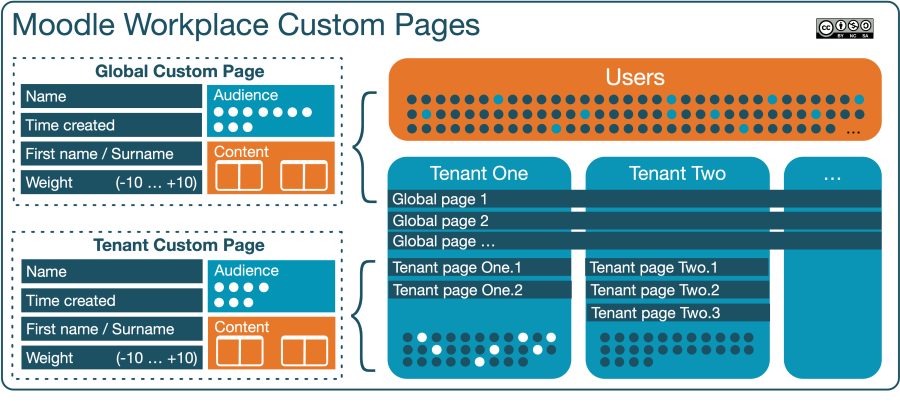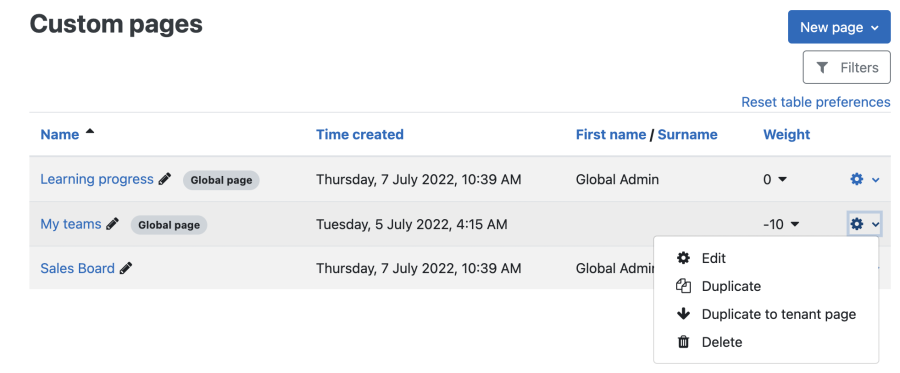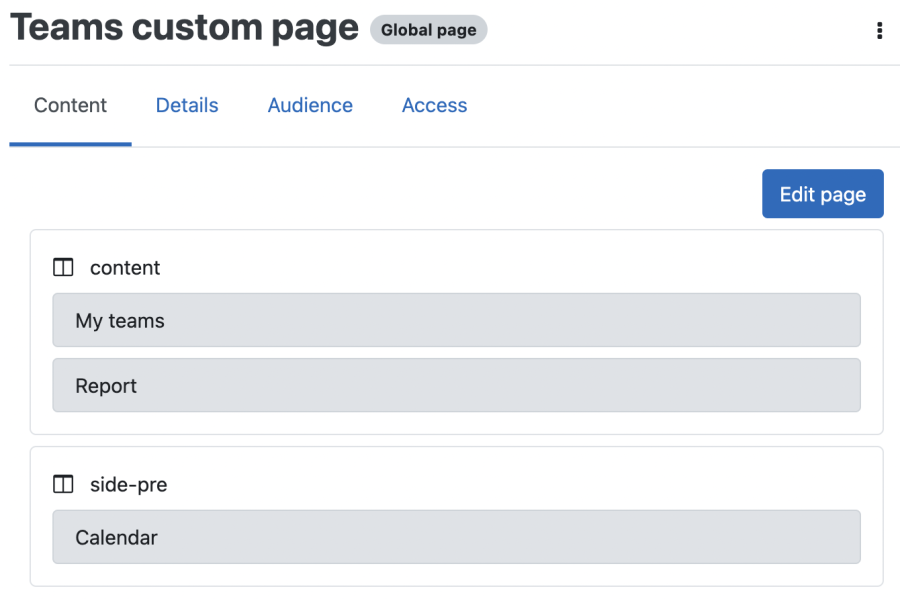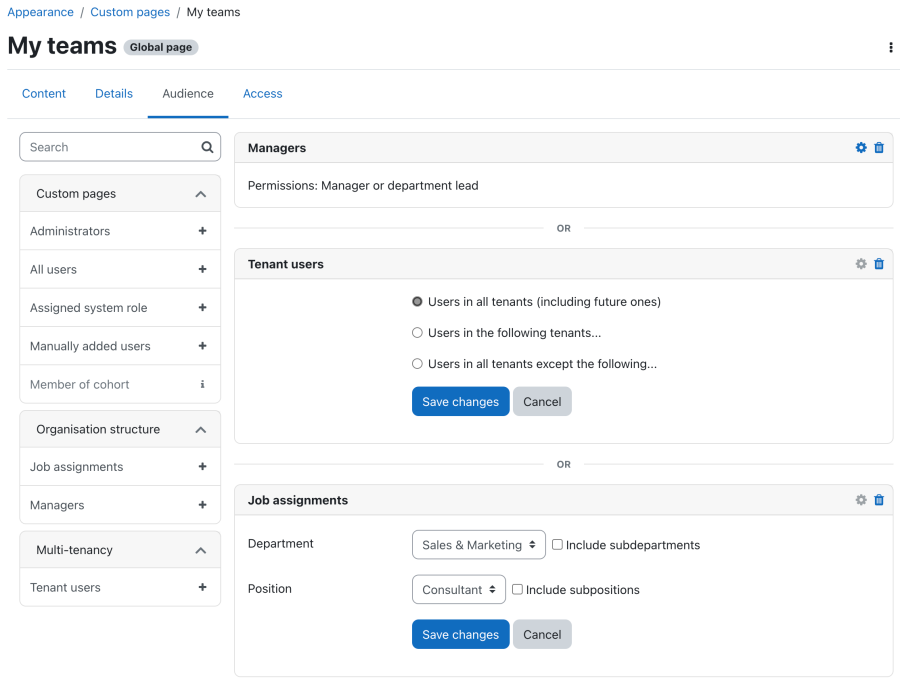Custom pages: Difference between revisions
| Line 1: | Line 1: | ||
Custom Pages | Custom Pages | ||
== Overview == | == Overview == | ||
Custom pages enable site and tenant administrators to create personalised experiences for different audiences by easily adding new | Custom pages enable site and tenant administrators to create personalised experiences for different audiences by easily adding new pages to the navigation. The content on these pages can be customised using standard Moodle Workplace blocks. | ||
There are two types of custom pages: | There are two types of custom pages: | ||
| Line 57: | Line 57: | ||
* '''Time created''': Date filters | * '''Time created''': Date filters | ||
* '''User''': Text filters | * '''User''': Text filters | ||
=== Creating new custom pages === | === Creating new custom pages === | ||
To create a new custom page, press the '''New page''' button and select one of the two options: | To create a new custom page, press the '''New page''' button and select one of the two options: | ||
* '''New global page''': create a custom page that is available across tenants | * '''New global page''': create a custom page that is available across tenants | ||
* '''New tenant page''': create a custom page that is only available in the current tenant | * '''New tenant page''': create a custom page that is only available in the current tenant | ||
[[File:New custom page.png|border|center|frameless|900x900px|alt=]] | [[File:New custom page.png|border|center|frameless|900x900px|alt=]] | ||
The fields to be provided are identical for both page types: | The fields to be provided are identical for both page types: | ||
* '''Name''': The name will be used as page heading and as the text in the primary navigation | * '''Name''': The name will be used as page heading and as the text in the primary navigation | ||
* '''Title in navigation''': The text in the primary navigation can be overriden here | * '''Title in navigation''': The text in the primary navigation can be overriden here | ||
| Line 75: | Line 71: | ||
As soon as you '''Save''' the settings, a new custom page will be created and you will be directed to the Content tab. | As soon as you '''Save''' the settings, a new custom page will be created and you will be directed to the Content tab. | ||
===Custom page content=== | |||
To add or edit the content of a custom page, select the '''Content''' tab and '''Edit page'''. Ensure that editing mode is also turned on! | |||
You can add custom blocks in any block region that has been defined in your theme. By default these are the center of the page ('''content''') and the block drawer ('''side-pre'''). Once you have completed the editing of the page, its structure is shown in the content tab. | |||
[[File:Custom pages - Content I.png|border|center|frameless|900x900px]] | |||
===Custom page audience=== | ===Custom page audience=== | ||
| Line 88: | Line 87: | ||
*'''Organisation structure''' | *'''Organisation structure''' | ||
**'''Managers''': Make pages available to all Managers, Department Leads or both. | **'''Managers''': Make pages available to all Managers, Department Leads or both. | ||
Multiple audiences are OR connected. | |||
=== Custom page access === | |||
To see who can view the custom page, select the '''Access''' tab of a page where you'll see a report that can be filtered by '''Full name'''.[[File:Custom pages - access.png|border|center|frameless|900x900px]] | |||
==Accessing custom pages== | ==Accessing custom pages== | ||
==Capabilities== | ==Capabilities== | ||
Revision as of 08:43, 12 July 2022
Custom Pages
Overview
Custom pages enable site and tenant administrators to create personalised experiences for different audiences by easily adding new pages to the navigation. The content on these pages can be customised using standard Moodle Workplace blocks.
There are two types of custom pages:
- Global custom pages are shared across all tenants, but they don’t require the Shared Space to be enabled.
- Tenant custom pages are specific to a single tenant which is selected on creation and can’t be changed later.
The following diagram demonstrates the key differences between global custom pages and tenant custom pages:
While the structure of both custom page types is identical, the reach and its audiences are different:
- Global pages are available across all tenants, a tenant page is restricted to the tenant it has been created in.
- Who can see a page is determined by the page audience. In global pages, the audience is a subset of all site users; in tenant pages it is a subset of all tenant users.
- ANYTHING ELSE?
Dashboards vs Custom Pages
What are the commonalities and difference between custom pages and dashboards?
COMMONALITIES
Dashboards:
- Dashboards are copied for each user when they log in for the first time.
- When a change is made in the site or tenant’s default dashboard page, it needs to be manually propagated to all users by resetting their dashboard configuration to the default.
- By default, users can edit their own dashboard (capability based).
Custom Pages:
- Custom pages are not copied for each user; they work as templates instead.
- Only site and tenant Administrators can create custom pages.
- Users can’t edit their own version of the custom pages.
- Changes are applied immediately to the custom pages for all users in the audiences.
Custom pages are read-only dashboards for different audiences. Thanks to custom pages, administrators are able to protect the dashboard by adding only essential blocks and organising everything else into custom pages, improving the experience for learners and managers.
Managing custom pages
You can access the management of programs via Site administration > Appearance > Custom pages or directly via the Custom pages icon in the Workplace launcher.
The following columns and actions are available for custom pages:
- Name: Name of custom page
- Type indicator: Global page or empty (tenant page)
- Time created: Self-explanatory
- First name / Surname: Name of page creator
- Weight: Indicates the order in which the page titles are shown in the user's navigation - the page with the the lowest number is shown first, the one with the highest number, last.
- Actions
- Edit: Change custom page content, details, and audience
- Duplicate: Create a copy of the custom page of the same type
- Duplicate to tenant page: Create a copy of a global page in a tenant (global pages only)
- Duplicate to global page: Create a copy of a tenant page as a global page (tenant pages only)
- Delete: Remove page
You can filter the custom page table by the following fields:
- Page type: Global page or Tenant page
- Name: Text filters
- Time created: Date filters
- User: Text filters
Creating new custom pages
To create a new custom page, press the New page button and select one of the two options:
- New global page: create a custom page that is available across tenants
- New tenant page: create a custom page that is only available in the current tenant
The fields to be provided are identical for both page types:
- Name: The name will be used as page heading and as the text in the primary navigation
- Title in navigation: The text in the primary navigation can be overriden here
- Weight: Specify the order this page will have in the primary navigation. Lower numbers will be displayed first.
As soon as you Save the settings, a new custom page will be created and you will be directed to the Content tab.
Custom page content
To add or edit the content of a custom page, select the Content tab and Edit page. Ensure that editing mode is also turned on!
You can add custom blocks in any block region that has been defined in your theme. By default these are the center of the page (content) and the block drawer (side-pre). Once you have completed the editing of the page, its structure is shown in the content tab.
Custom page audience
Custom page audiences indicate which users have access to the page. To access audiences, select the Audience tab of a custom page.
You can create the following audiences:
- Custom pages
- All users: Use this audience to give access to all users in the tenant to any report
- Assign system roles: Select at least one system role
- Manually added users: Select at least one user (via name or e-mail address). Only email addresses of registered users being are supported as schedule recipients.
- Organisation structure
- Managers: Make pages available to all Managers, Department Leads or both.
Multiple audiences are OR connected.
Custom page access
To see who can view the custom page, select the Access tab of a page where you'll see a report that can be filtered by Full name.
Accessing custom pages
Capabilities
TODO
| Capability |
|---|
| Custom pages |
| Edit custom pagestool/custompage:edit |
| Edit all custom pagestool/custompage:editall |
| Duplicate custom page blocks without validationtool/custompage:skipblockvalidation |





